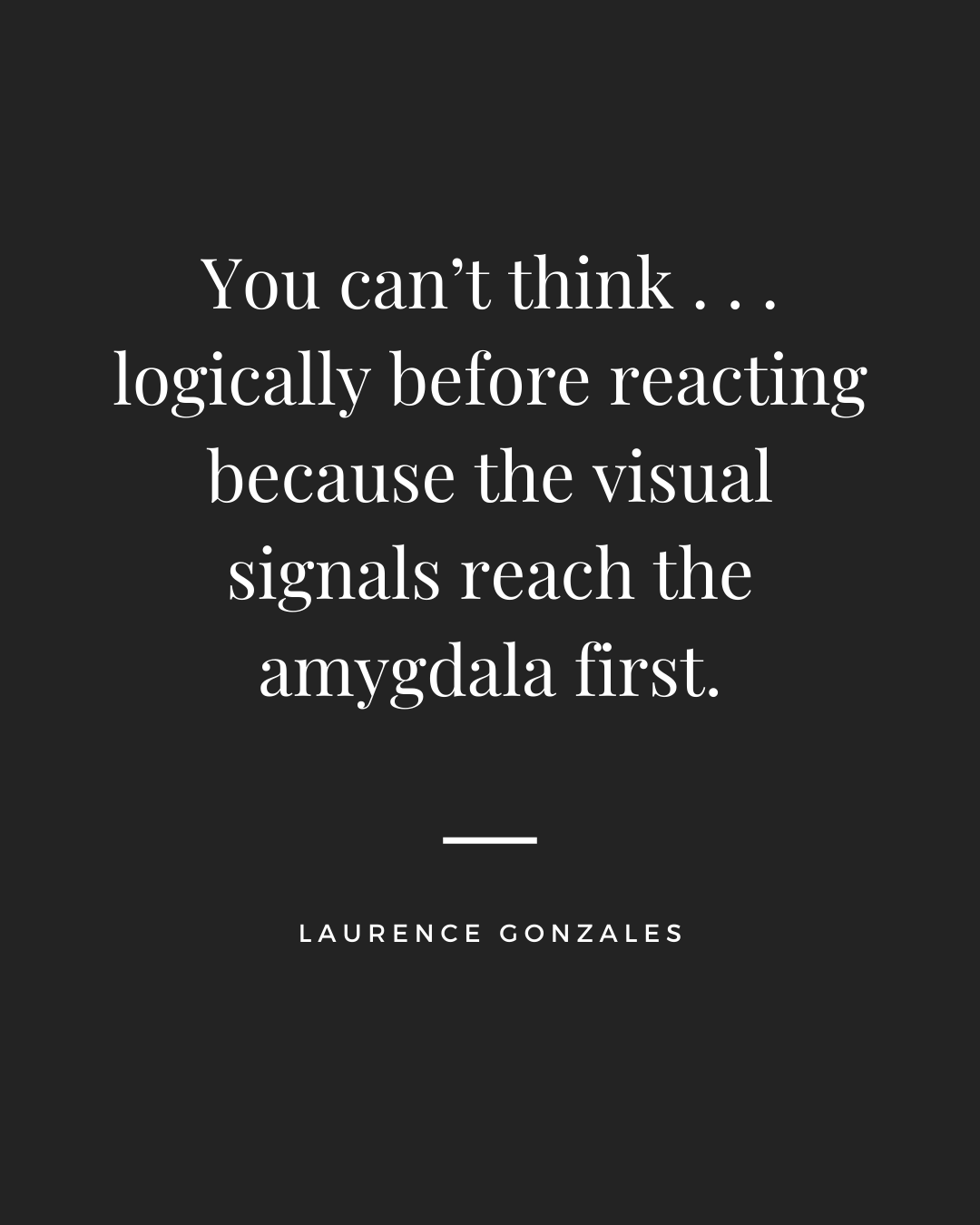Which came first
the thought or the emotion?
I have written (more than once, sorry) that thoughts are the basis of our emotions. In other words, every time you have an emotion, it’s because there is a thought behind it that produces the emotion, which sounds like the thought comes first and is followed by the emotion.
Well, I am here to admit to the whole internet that I was wrong. It could happen that way sometimes, as when you think of a loved one you’ve lost and then feel sad. But it could be the other way around. Let me explain.
In the last few weeks I’ve been hearing and reading that emotions happen faster (and therefore sooner) than thoughts do. According to neuroscience, this is true. What I have read upon further Googling is that sensory input goes to the limbic system first, which includes the amygdala (that’s the seat of emotion and the fight-or-flight response), and then in a more round-about way, the input also goes to the prefrontal cortex, where decisions are made and rational thought takes place. But the shortcut is to the limbic system. According to the Cleveland Clinic, “The limbic system is a group of interconnected brain structures that help regulate your emotions and behavior.” Notice it does not include your thoughts.
But let me back up a bit.
Eight or nine years ago when we lived in Asheville, I got into hiking. No surprise, since the mountains of Western North Carolina are home to miles and miles of beautiful and easily accessible trails. The more I hiked, the more I wanted to explore. So I began reading about famous hikes and hikers. I read about the successful ones and a few who, despite being well prepared and physically capable, died in the wilderness. (I’ll include a book list at the end.)
Then I read Deep Survival (by Laurence Gonzales) and my mind was (figuratively, not literally) blown. The subtitle of this book is Who Lives, Who Dies, and Why. Are you intrigued? I couldn’t put it down.
The author begins the book by recounting his experiences with fighter pilots landing F-18s on the deck of the USS Carl Vinson, an aircraft carrier, in the dead of night, and how one flew right into the tail of the ship, cutting the plane in two and “sending the pilot skittering across the deck in a shower of sparks, still strapped into his Martin-Baker ejection seat” (p 26).
The obvious question is how does this happen to one of the most intelligent, best-trained aviators in the world? What was he thinking?
The short answer is that he was not thinking. His rational brain was overruled by his emotional brain, which was screaming at him that the deck = safety. Get down now! This happens when the person is under a tremendous stress load, as is the case when trying to catch a wire on the deck of a ship that is, itself, not stationary, with a little tailhook on a plane traveling 150 mph at night with only instrumentation and the screaming voice of the landing signal officer (LSO) in your headset.
I still have this book on my shelf years later and had kind of forgotten about it until recently when I started hearing about how emotion works faster than thought, and I went back and started reading it again. And lest you don’t believe me, I will share a few highlights.
Emotion is an instinctive response aimed at self-preservation. It involves numerous bodily changes that are preparations for action. The nervous system fires more energetically, the blood changes its chemistry so that it can coagulate more rapidly, muscle tone alters, digestion stops, and various chemicals flood the body to put it in a state of high readiness for whatever needs to be done. All of that happens outside of conscious control. Reason is tentative, slow, and fallible, while emotion is sure, quick, and unhesitating. (p 31)
Don’t believe me? Think about the last time someone you know jumped out from behind a door and scared you silly. Which reaction happened first—fear or rational thought?
When the pilot was on his final approach to the Vinson, fear rose up in him, as it should. Getting his multi-million-dollar aircraft (and himself) on the deck is a highly technical feat. The problem was that his fear overrode his ability to pay attention to all the information that was telling him he was coming in too low—the instruments, the LSO yelling, the bright lights flashing. Joseph LeDoux calls this “hostile takeover of consciousness by emotion.” Tony Overbay, LMFT, calls it “the amygdala hijack.” Gonzalez adds, “The body knows where safety is . . . The pilot had developed a powerful secondary emotion, which told him that safety and even ecstasy could be found on the ground (or the deck) and that if he could just get . . . down, he’d be all right.” That powerful emotion overrode all intellectual knowledge of how and whether to land the plane.
Throughout life with all of its experiences, our brain creates “somatic markers,” a term coined by Antonio Damasio. When we have an experience we like, one that makes us feel good, the brain bookmarks that feeling. When we experience a traumatic event—abuse, an accident, war—the experience makes us feel bad and the brain bookmarks that too—the feeling, not the event.
Gonzalez says,
When a decision to act must be made instantly, it is made through a system of emotional bookmarks. The emotional system reacts to circumstances, finds bookmarks that flag similar experiences in your past and your response to them, and allows you to recall the feelings, good or bad, of the outcomes of your actions. (p 51)
In the case of our once-pilot (alas, after wrecking an F-18, he is a pilot no more), “at the critical moment of decision, reason was not enough to overcome emotion” (p 54). His emotional brain was screaming for him to get the plane on the deck in spite of all the evidence directed to his rational brain that it was a bad idea in that moment. The compulsion to survive is strong. Tony Overbay says our brain is “one big keep-you-alive machine.”
Gonzalez concludes that “[T]hose who can control that impulse to survive, live. Those who can’t, die.” This explains why some pilots live and others don’t. Why one mountain climber who breaks a leg at 19,000 feet in the snow-covered Andes lives and his partner (without a broken leg) does not.
So what is it that makes one person able to resist the survival instinct and focus on making rational decisions and another unable? It is not character. “As Joseph LeDoux put it, ‘People don’t come preassembled, but are glued together by life’” (p 61). Our emotional system is continually being formed by our experiences and creating somatic bookmarks that dictate our future actions. Will we startle or laugh when a friend jumps out to scare us? Past experiences hold the answer.
Gonzalez concludes that “[R]ational (or conscious) thought always lags behind the emotional reaction” (p 65). So the answer to the question is the emotion comes first, microseconds before the input has even arrived at the thinking brain.
I don’t know about you, but that makes me feel better. No more self-shaming for our bodies’ responses to situations where they are relying on somatic bookmarks to judge whether we are safe or not. Our brain is doing the best it can given the experiences we’ve lived through. We may not always understand why we react the way we do, but it is in alignment with the way God created our brains and bodies—with the instinct to survive—and emotional reactions are just one way they do that.
A few books I’ve enjoyed (affiliate links):
Where You’ll Find Me: Risk, Decisions, and the Last Climb of Kate Matrosova
When You Find My Body: The Disappearance of Geraldine Largay on the Appalachian Trail
Into the Wild
The Last Season
At the Mercy of the Mountains



